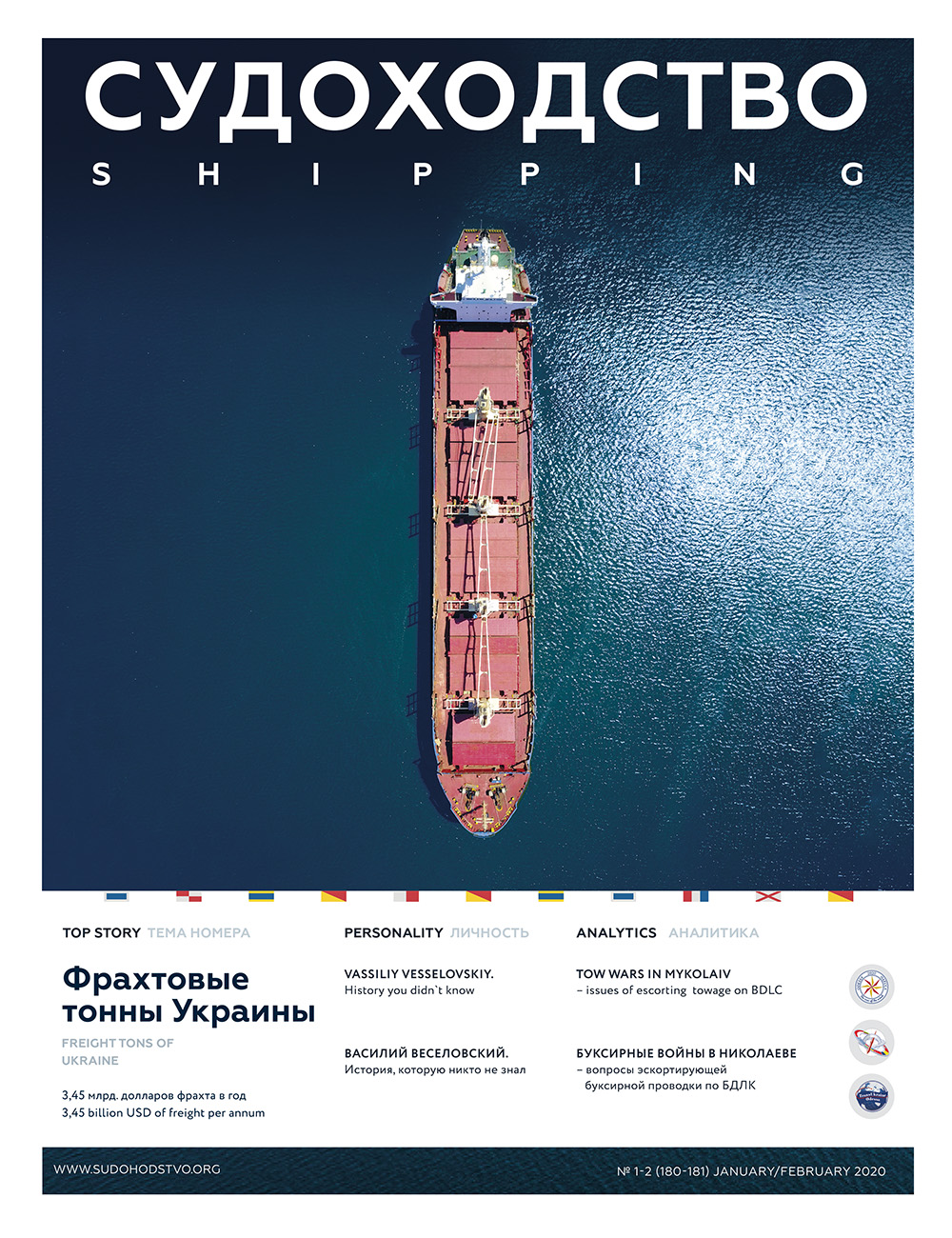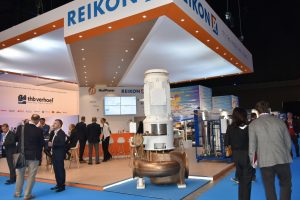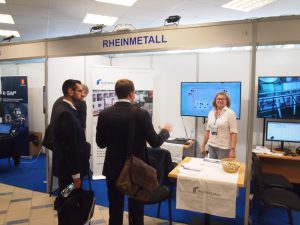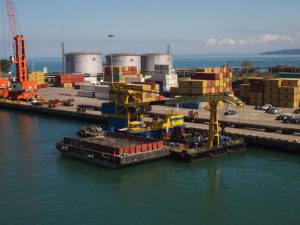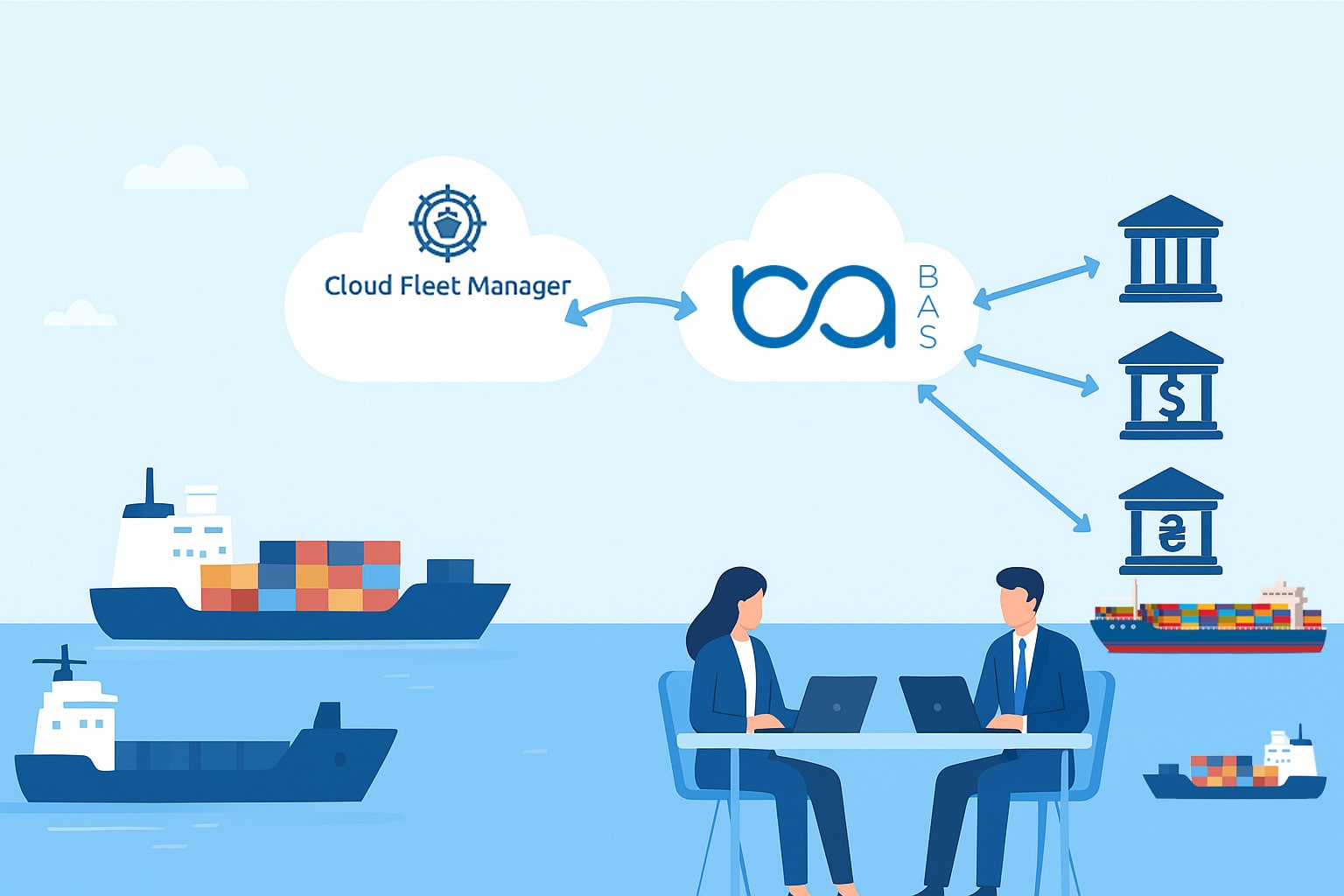
Fleet management today goes far beyond voyages and technical maintenance. Shipowners face new challenges – the need for transparency, compliance with international reporting standards, and faster decision-making. The integration of Cloud Fleet Manager and BAS unites maritime operations and financial accounting, creating a single ecosystem – from voyage to balance sheet. This solution opens new opportunities for Ukrainian and European companies in the highly competitive shipping industry.
Shipping remains the backbone of the global economy: more than 80% of international cargo transportation is carried out by sea. For Ukraine and Europe, this sector is particularly important, as it ensures not only the export and import of strategic goods – grain, metals, energy resources, and industrial equipment – but also supports the stability of supply chains in times of geopolitical turbulence. Increasingly, the speed of data processing, process transparency, and compliance with international and environmental standards are becoming crucial. That is why shipping companies are turning more and more often to digital solutions that help manage fleets more efficiently, safely, and cost-effectively.
However, traditional approaches – Excel spreadsheets, paper documentation, and a set of disconnected software tools – no longer meet modern requirements and cannot keep up with the growing volume of data.
Automated fleet management system
Modern shipping companies, charterers, and shipowners require specialized Automated Fleet Management Systems (AFMS) to manage fleets effectively. These systems integrate all key processes into a unified digital environment: from vessel management and voyage planning to crew operations, procurement, technical maintenance, and financial accounting. Such systems are valuable for both large corporations and medium-sized companies aiming to make operations more transparent, reduce costs, and simplify interaction with partners.
Cloud-based solutions are especially effective, as they provide real-time data access from anywhere in the world. These systems offer a high degree of automation and easily integrate with international and local accounting systems. This not only reduces operational expenses but also gives businesses a strategic advantage in the global market.
At the same time, beyond AFMS, every company must maintain its own managerial and financial accounting. When two different systems are used, there arises a need to automate data exchange between them.
In this article, we will examine a real-world project of integrating financial and managerial accounting with the popular European AFMS “Cloud Fleet Manager” (CFM).
What is “Cloud Fleet Manager”?
Cloud Fleet Manager (CFM) is a cloud-based system developed by the German company Hanseaticsoft (part of Lloyd’s Register), which integrates into one platform:
- vessel and voyage management,
- crew management,
- procurement and supply,
- technical maintenance,
- primary data for financial accounting and reporting
CFM key features:
CFM consists of several modules that can be connected as needed:
- Fleet Manager – stores data on each vessel (specifications, certificates, repairs, status).
- Crew Manager – crew management: contracts, schedules, medical checks, certification.
- Maintenance Manager – scheduled and unscheduled maintenance, repair tracking.
- Purchase Manager – procurement, vessel supply, warehouse management.
- Safety Manager – compliance with ISM/ISPS requirements, checklists, incident reports.
- Charter & Voyage – voyage and charter management, cost and revenue calculation.
- Partner Portal – dedicated access for clients and partners (to view schedules, voyage status, reports).
- Reporting & Analytics – ready-to-use reports and dashboards for management.
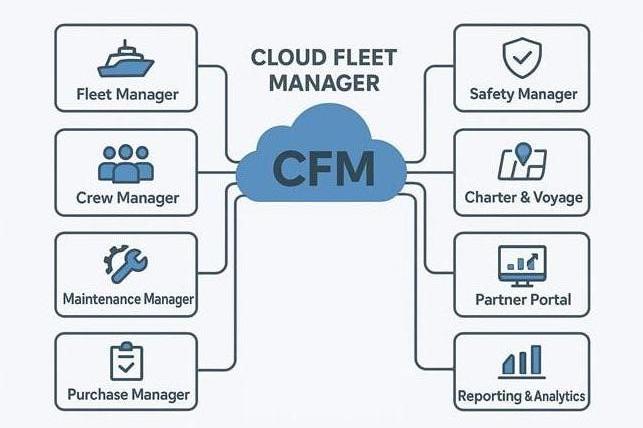
What are the advantages of using this system:
- Centralization – everything in one system, no scattered files or databases.
- Global access – works in a browser or mobile app, requires only internet access.
- Transparency – shore-based staff, crew, and partners have access to up-to-date data.
- Automation – less manual work, faster information exchange.
- Compliance with international standards – supports IMO, ISM, ISPS, MLC requirements.
- Flexibility – only required modules can be connected (e.g., just Crew + Maintenance).
Integration with financial (accounting and management) BAS family systems
CFM does not provide full functionality for accounting, management reporting, or budgeting. Therefore, it is important to integrate CFM with the company’s financial accounting system.
Integration requires:
- synchronization of reference data (counterparties, holding structure companies, goods and services, currencies, units of measure, etc.).
- integration of invoices and orders (e.g., for fuel and spare parts);
- cash flow operations (including payroll and salary payments).
There are three main integration scenarios: Minimal – real-time data collection, with invoices checked in the accounting system. Intermediate – transfer of orders with invoice verification in the accounting system. Full synchronization – complete control and synchronization within CFM.
For correct operation of CFM and the accounting (management) system, integration of counterparties is essential. Otherwise, maintaining lists manually in both systems may cause errors. First, the “leading system” is defined. It creates and updates records of counterparties, assigning the main identifier (usually the “counterparty ID”). Data is then synchronized via API. If CFM is the leading system – the accounting system receives updates. If the accounting system is leading – it sends updates to CFM.
CFM supports API-integration, which allows you to:
- transfer of financial voyage data to BAS(revenues, expenses, port changes, fuel);
- uploading procurement and supply data (requests in CFM converted into orders and invoices in BAS);
- synchronization of crew data (contracts, salaries, taxes);
- accounting for repairs and maintenance (expenses and material transferred to accounting).
- and much more.
In Ukraine, the most popular accounting and management systems are BAS family products.
European companies also use similar products, but unlike Ukrainian counterparts, they usually include:
- Multilingual interface – the systems are available in different languages, which facilitates their use in international operations. Moreover, each workstation and each employee can simultaneously work with the interface in the language convenient for them.
- Built-in modules for international trade: multi-currency accounting, management of branches in different jurisdictions, warehouses, and divisions.
In one of the projects implemented in 2025, the company «Art Port» developed a solution for software integration between CFM and BAS family products.
The Client Company was already actively using Cloud Fleet Manager for vessel, crew, and procurement management but faced the need to connect it with financial accounting in compliance with both international and local standards.
As part of this project, it was necessary to develop integration between the two systems that would:
- Automate data exchange between CFM and BAS;
- Ensure transparency in voyage expense and revenue calculation;
- Simplify the preparation of financial and tax reporting.

The actual data exchange from CFM to BAS looks like the push of a single button. But behind this button lies the massive amount of work carried out to enable information exchange between the two systems.

Uploading invoices from CFM into BAS
Let’s consider a few example scenarios of CFM-BAS integration
1. Voyage and charter management:
- In CFM: the dispatcher plans a voyage; the system records fuel consumption, port charges, and freight income.
- Exchange with BAS: the data is automatically exported as financial documents (voyage revenues/expenses).
- In BAS: the financial result for the voyage is generated, along with reports for accounting and management purposes.
2. Procurement and supply:
- In CFM: the crew or office submits requests for vessel supplies (food, spare parts, equipment).
- Exchange with BAS: the request is transformed into a “Purchase Order”.
- In BAS: warehouse accounting is maintained, invoices are processed, inventory balances are automatically updated, all related operations are executed and documented, and reports are generated.

Bank documents and supplier invoices
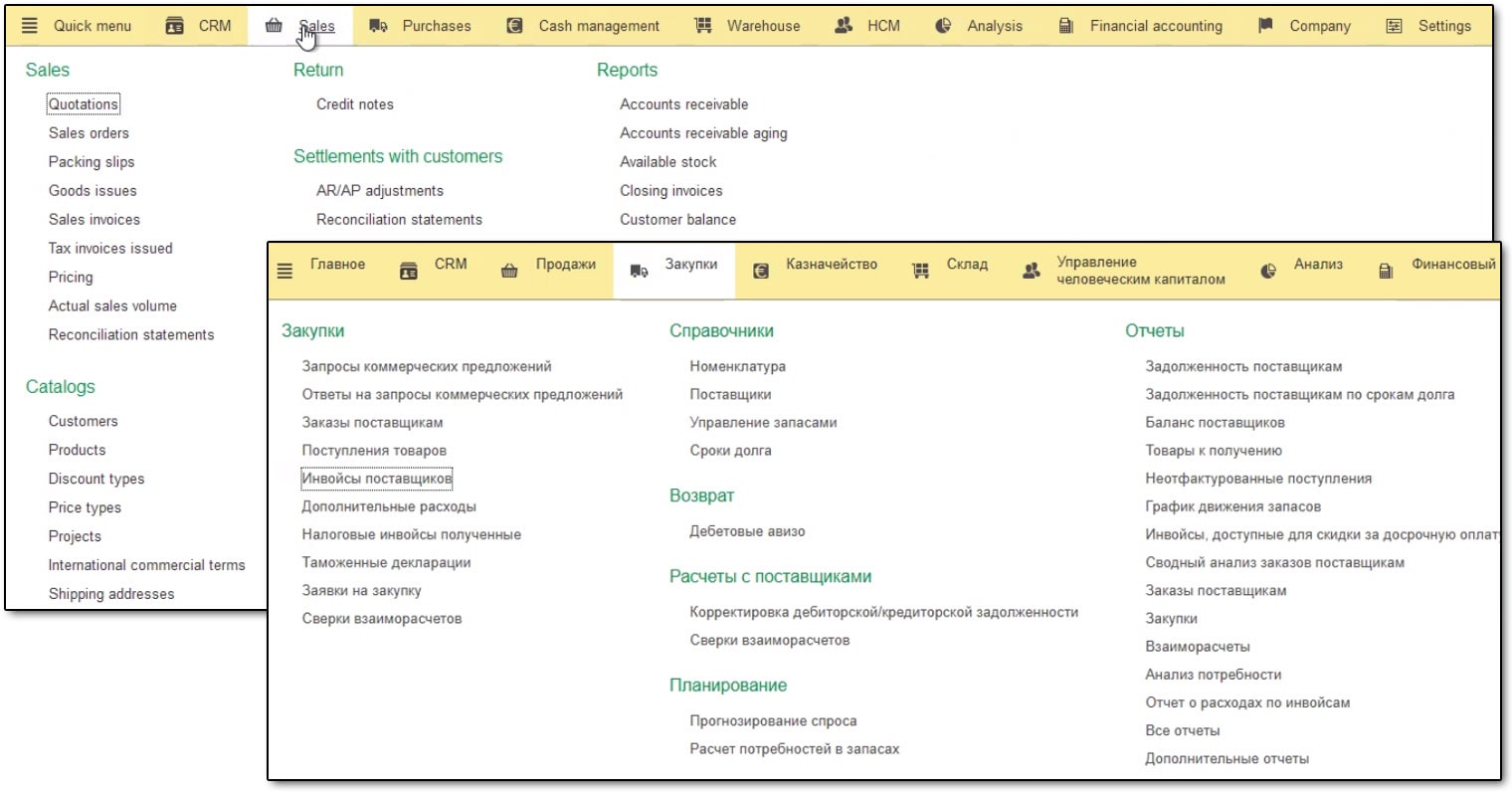
Procurement and sales in the accounting system in selected languages
3. Crew management:
- In CFM: seafarer contracts, rotation schedules, and salaries are stored.
- Exchange with BAS: salary and tax data are exported for payroll calculation and reporting.
- In BAS: payroll and tax calculations are performed, integration and data exchange with Ukrainian or European banks are supported (statements, payments, etc.), and reports for regulatory authorities are generated.

Payroll for the crew
4. Technical maintenance and repairs:
- In CFM: the system records scheduled and emergency repairs, along with maintenance expenses.
- Exchange with BAS: expenses are exported into BAS products.
- In BAS: accounting entries are posted to financial/management accounts, materials are written off, service acts are generated, repair and maintenance costs are closed, and asset accounting is maintained.
5. Financial analytics and reporting:
- In CFM: analytics can be built by voyage, fleet, and supply.
- In BAS: this data is supplemented with local reporting (VAT, corporate income tax, balance sheet, etc.).
- Result: management receives a single financial window — international analytics (CFM) + local reporting in BAS products.

Analysis and reports
Benefits of such integration
- Unified information flow – data is entered once and automatically transferred to both CFM and BAS products.
- Automated accounting – voyage expenses and revenues are instantly reflected in financial records.
- Error reduction – minimal manual input and elimination of document duplication.
- International standards + local reporting – CFM provides fleet analytics, while BAS products generate reports for regulatory and tax authorities.
- Increased transparency for management – a single dashboard combining international and local performance indicators.
Who benefits from this?
In Europe – medium and large shipping companies (5-200 vessels) working with international clients and partners. Integration of CFM with local ERPs ensures full compliance with market and regulatory requirements.
In Ukraine – shipping, forwarding, and logistics companies operating under Ukrainian accounting rules and required to submit reports to local authorities. Integration of CFM with BAS allows such companies to work according to international standards while fully complying with Ukrainian accounting regulations.
Final outcomes
After implementing this project, the client company achieved the following benefits:
- A unified system was created – from order entry in CFM to accounting and reporting in BAS.
- Reduced manual work, elimination of errors and “human factor”.
- Full synchronization of operations and data in CFM and BAS.
- Faster calculations and preparation of reports under both international (IFRS) and local standards.
- Automation interaction with banks.
- Readiness for scaling.
- Full transparency for management – a single window with fleet and financial data.
The developed solution enables:
- Seamless data exchange between CFM and accounting/management systems in BAS.
- Monitor the movement and control of funds allocated to each expense item for the voyage
- Exchange information with Ukrainian and foreign banks.
Cloud Fleet Manager is not just a fleet management tool but a full-fledged digital ecosystem for the shipping business.
Integration with BAS products transforms CFM into a universal solution: international standards + local reporting.
And this is not just a technical solution. It is a strategic step toward the company’s digital maturity, compliance with international requirements, and increased competitiveness.
The solution developed by “Art Port” turns complex processes into transparent data flows – from voyage to balance sheet, from invoice to report.




